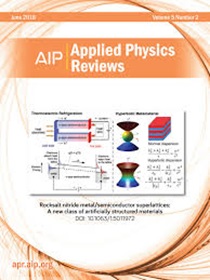Liquid-metal-assisted exfoliation of 2D β-Ga2O3 with high anisotropy ratio for solar-blind detection and polarization imaging
IF 11.9
1区 物理与天体物理
Q1 PHYSICS, APPLIED
引用次数: 0
Abstract
Solar-blind UV polarization detection and imaging can reflect more detailed optical information, which is vital for developing next-generation deep UV optoelectronic devices. β-Ga2O3 with ultra-wide bandgap is an ideal candidate for solar-blind UV detection application. However, the bulky nature of Ga2O3 limits its application in miniaturized, integrated and multifunctional devices, and polarization imaging based on Ga2O3 photodetector has not yet been realized. Here, we report a convenient method to prepare 2D β-Ga2O3 flakes via liquid-metal-assisted exfoliation. Benefiting from high crystallinity and polarization-sensitive absorption of prepared ultrathin β-Ga2O3 flake in monoclinic structure, the β-Ga2O3 photodetector exhibits an ultra-fast response speed (100/78 μs for rise/decay time) and a prominent anisotropy ratio (∼2.8) of polarization photoresponse under 265 nm illumination. An unambiguous detection of linearly polarized light has also been realized by the double symmetry-breaking of twisted β-Ga2O3 photodetectors. Moreover, a four-layer twistedly stacked detection system further enables a one-step and well-defined polarization imaging with high resolution (150 × 150 pixels) to acquire spatial polarization information. This work presents a novel strategy for preparing ultrathin 2D gallium oxides and demonstrates a promising route to realize well-defined solar-blind polarization imaging in a simple manner.求助全文
约1分钟内获得全文
求助全文
来源期刊

Applied physics reviews
PHYSICS, APPLIED-
CiteScore
22.50
自引率
2.00%
发文量
113
审稿时长
2 months
期刊介绍:
Applied Physics Reviews (APR) is a journal featuring articles on critical topics in experimental or theoretical research in applied physics and applications of physics to other scientific and engineering branches. The publication includes two main types of articles:
Original Research: These articles report on high-quality, novel research studies that are of significant interest to the applied physics community.
Reviews: Review articles in APR can either be authoritative and comprehensive assessments of established areas of applied physics or short, timely reviews of recent advances in established fields or emerging areas of applied physics.
 求助内容:
求助内容: 应助结果提醒方式:
应助结果提醒方式:


